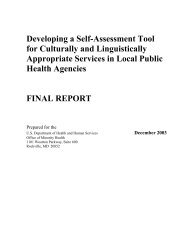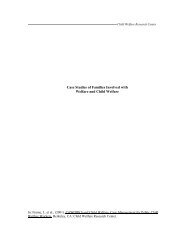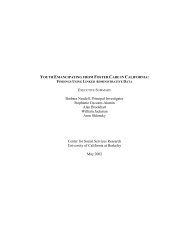the treatment utility of the various <strong>in</strong>struments are needed, especially with respect to childwelfare populations.Parent<strong>in</strong>g PracticesIn addition to the seven comprehensive measures of family assessment and the fourspecialized measures of patterns of family social <strong>in</strong>teraction, five measures were identified aspromis<strong>in</strong>g <strong>for</strong> the specialized assessment of parent<strong>in</strong>g practices among families that have cometo the attention of the child welfare system: (1) the Adult-Adolescent Parent<strong>in</strong>g Inventory(AAPI); (2) the <strong>Child</strong> Abuse Potential Inventory (CAPI); (3) the Parental Empathy Measure(PEM); (4) the Parent<strong>in</strong>g Stress Index (PSI); (5) and the Beavers Model of <strong>Family</strong> <strong>Assessment</strong>(see Figure 6).Figure 6. Promis<strong>in</strong>g Measures of Parent<strong>in</strong>g PracticesInstrumentIntake/Screen<strong>in</strong>g<strong>Child</strong> <strong>Welfare</strong> Decision/Stage of <strong>Assessment</strong>Investigation/DiagnosisCasePlann<strong>in</strong>gCont<strong>in</strong>u<strong>in</strong>g <strong>Services</strong>,Placement &Reunification/Monitor<strong>in</strong>g &EvaluationAdult-Adolescent Parent<strong>in</strong>g Inventory X X X<strong>Child</strong> Abuse Potential Inventory (CAPI) X XParent<strong>in</strong>g Stress Inventory (PSI)XParental Empathy Measure (PEM)XBeavers Model of <strong>Family</strong> <strong>Assessment</strong> X X X XX = child welfare decision/stage of assessment <strong>for</strong> which <strong>in</strong>strument is usedAdult-Adolescent Parent<strong>in</strong>g Inventory (AAPI). The AAPI is designed to identify highriskparent<strong>in</strong>g activities and behaviors that are known to be attributable to child abuse andneglect, and may also be used to assess patterns of family social <strong>in</strong>teraction. It is a self-report<strong>in</strong>ventory consist<strong>in</strong>g of <strong>for</strong>ty five-po<strong>in</strong>t Likert scale items, and can be adm<strong>in</strong>istered at multiplepo<strong>in</strong>ts over the course of a child welfare case <strong>for</strong> the purposes of screen<strong>in</strong>g, diagnosis, andmonitor<strong>in</strong>g progress and cl<strong>in</strong>ical change over time. Advantages of this <strong>in</strong>strument <strong>in</strong>clude a briefadm<strong>in</strong>istration time of approximately twenty m<strong>in</strong>utes and suitability <strong>for</strong> parents with a fifthgraderead<strong>in</strong>g level or above. Additionally, the AAPI can be read orally to non-readers and aSpanish version is available <strong>for</strong> Spanish-read<strong>in</strong>g parents. Over twenty years of research haveprovided considerable evidence of the psychometric strength of this <strong>in</strong>strument, <strong>in</strong>clud<strong>in</strong>g high<strong>in</strong>ternal consistency and significant diagnostic and discrim<strong>in</strong>atory validity <strong>in</strong> discern<strong>in</strong>g nonabusiveparents and known abusive parents (Bavolek & Keene, 2001).18
<strong>Child</strong> Abuse Potential Inventory (CAPI). The CAPI is also designed to identify parentswho are most likely to be at risk <strong>for</strong> child abuse by assess<strong>in</strong>g problematic parent<strong>in</strong>g practices andsocial <strong>in</strong>teraction, and was developed as a tool specifically <strong>for</strong> child protective services workers<strong>in</strong> their <strong>in</strong>vestigations of reported child abuse cases. While the CAPI was orig<strong>in</strong>ally designed asa prelim<strong>in</strong>ary screen<strong>in</strong>g tool to discrim<strong>in</strong>ate between abusive and non-abusive parents,treatment/<strong>in</strong>tervention programs have successfully used the CAPI at pre- and post-treatment toassess progress and cl<strong>in</strong>ical change (Milner, 1994). It is a self-adm<strong>in</strong>istered 160-itemquestionnaire that assesses six primary cl<strong>in</strong>ical factors: (1) distress, (2) rigidity, (3) unhapp<strong>in</strong>ess,(4) problems with child and self, (5) problems with family, and (6) problems with others.Additionally, the <strong>in</strong>strument <strong>in</strong>cludes three validity subscales that help mitigate potential selfreportbias. Other advantages of the CAPI <strong>in</strong>clude a brief adm<strong>in</strong>istration time of approximatelytwenty m<strong>in</strong>utes and a third-grade read<strong>in</strong>g level requirement that permits its suitability <strong>for</strong> usewith parents with limited literacy proficiency. Similar to the AAPI, the CAPI has undergonesubstantial psychometric evaluations and has demonstrated significant discrim<strong>in</strong>ative validity,high <strong>in</strong>ternal consistency and test-retest reliabilities (He<strong>in</strong>ze & Grisso, 1996).Parental Empathy Measure (PEM). The PEM is a promis<strong>in</strong>g <strong>in</strong>strument <strong>for</strong> screen<strong>in</strong>g<strong>for</strong> abusive or neglect<strong>in</strong>g parent<strong>in</strong>g behaviors/practices. It is a semi-structured <strong>in</strong>terview withopen-ended questions assess<strong>in</strong>g parental attention to signals, attributes, emotional/behavioralresponses to, and perceptions of their children. In addition to these parent<strong>in</strong>g practices andbehaviors, the PEM <strong>in</strong>cludes items address<strong>in</strong>g past <strong>in</strong>volvement with child protective services.One of the strongest features of this <strong>in</strong>strument is the comprehensiveness of its psychometricevaluation; reliability and validity tests <strong>in</strong>dicate that the PEM has good sensitivity <strong>for</strong> identify<strong>in</strong>gabusive parents, good <strong>in</strong>ter-rater reliability, high <strong>in</strong>ternal consistency, and high constructreliability when measured aga<strong>in</strong>st the CAPI. Furthermore, the PEM also <strong>in</strong>cludes a measure ofsocial desirability that was found to be effective <strong>in</strong> detect<strong>in</strong>g biased responses. However, thePEM lacks the advantage of adm<strong>in</strong>istrative brevity exhibited by the previous measures; <strong>for</strong>example, the PEM conta<strong>in</strong>s open-ended items and general adm<strong>in</strong>istration time cannot beestimated because it depends on specific case characteristics (Kilpatrick, 2005).Parent<strong>in</strong>g Stress Index (PSI). The PSI also screens <strong>for</strong> abusive or neglect<strong>in</strong>g parent<strong>in</strong>gbehaviors/practices, and assesses social <strong>in</strong>teraction characteristics that may affect the quality offamily function<strong>in</strong>g. The current version of the PSI conta<strong>in</strong>s 101 self-report items assess<strong>in</strong>g the19
















